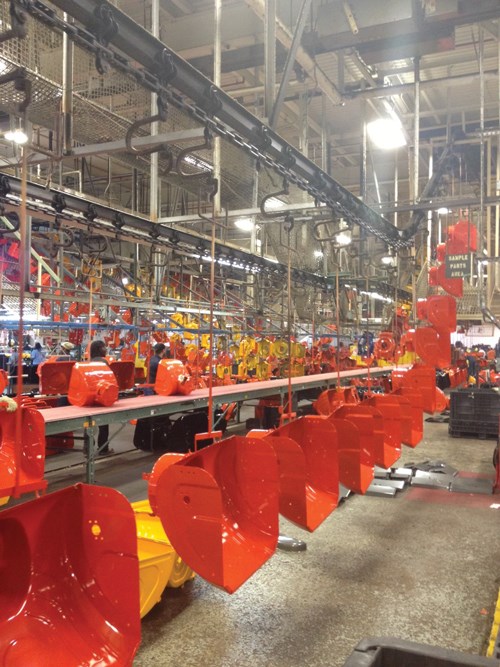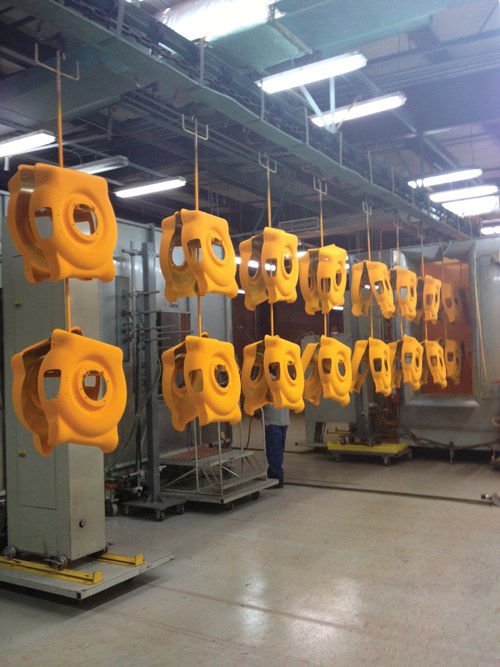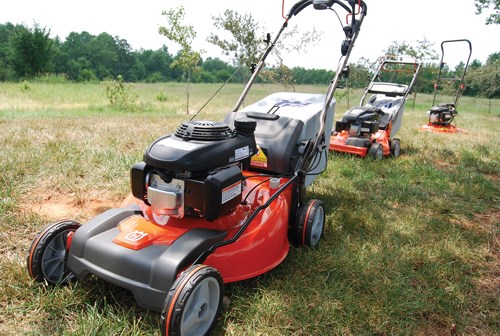Cutting Down Pretreatment Waste and Water
Husqvarna Outdoor Products replaces phosphate pretreatment system after the company launched an initiative at its numerous manufacturing plants around the world to go greener and reduce the amount of waste being discharged.
After almost 40 years in the industrial coating business on the manufacturing side, Harry Holland never envisioned himself an innovator, let alone a guinea pig.
“When something works well, you want to stick with it and not change it,” says Holland, finishing manager at Husqvarna Outdoor Products’ manufacturing plant in McRae, Ga., which makes lawn mowers, garden tillers, snow throwers and trimmers.
That includes pretreating parts for powder coating those mowers and tillers sold at major U.S. stores such as Lowe’s, which needless to say means outdoor products need to be coated properly to ensure customer satisfaction.
“I’ve been in this business more than 38 years, and one thing I know is that you have to meet those paint specs every time all the time,” Holland says. “You won’t last if you don’t.”
But what finishing managers like Holland face every day is the balance between routinely getting nine and 10 ratings on salt-spray tests, and satisfying his company’s desire to become a greener, more eco-friendly manufacturer.
Power Products
That’s what Holland faced when Husqvarna—the world’s largest producer of outdoor power products including robotic lawn mowers, garden tractors, zero turns, snow blowers, chainsaws and trimmers—launched an initiative at its numerous manufacturing plants around the world to go greener and improve its production systems to reduce the amount of waste being discharged, as well as to use cleaner chemistry.
The chore in the U.S. fell to Holland, who has been with the Swedish-based Husqvarna since back when the company was known as Electrolux and also owned the Frigidaire line of white goods for the kitchen.
Electrolux spun off Husqvarna as its own company in 2006, and the division also boasts a number of strong brands that include Gardena, McCulloch, PoulanPro, WeedEater, Dixon and Bluebird.
Husqvarna Group products and private label brands are sold in most mass channels and more than 4,000 independent dealers nationwide.
But being an international company means also trying to stay in front of environmental concerns around the globe, which is why Husqvarna launched the idea of taking a hard look at its production processes to see where improvements could be made, where ecological changes could occur, and also where cost-savings could be had.
Less Waste, More Efficient
Holland says he went over his pretreatment and powder coating lines thoroughly before deciding to investigate the switch from their conventional iron phosphate to one that had less waste, was more energy efficient and used less water than before.
One of the first things Holland did was sit down with David VanLeuven, technical sales manager for chemical supplier Chemetall US, Inc, to discuss a plan for conversion.
The Husqvarna-Chemetall relationship goes back almost 20 years to when the supplier helped Holland convert from an alkaline to an acid cleaner in 1996, which saved more than 5 million gallons of waste water annually at the former Electrolux manufacturing plant.
So it was with a good track record that VanLeuven began working with Holland on the nine-stage washer system, first starting with some testing during a weekend in 2012 with Chemetall’s Oxsilan, a non-phosphorous pretreatment that is a drop-in replacement for iron phosphate processes.
Gary Nelson, Oxsilan product manager for Chemetall, says that phosphorous is coming under growing discharge restrictions from regulatory authorities, and that many of these regions have limits or surcharges that range from as high as 25 mg/l to as low as 1 mg/l of phosphorous.
“To give a point of reference, a conventional iron phosphate bath might contain 500-1,000 mg/l of phosphorous and the rinse stage after it may contain15-30 mg/l, assuming a three percent contamination level in the rinse,” Nelson says.
Testing Chemistry
VanLeuven met with Holland and his staff on a Saturday morning to run some test samples with the new chemistry before converting it back on Monday.
“We started with about 300 test panels, ranging from a low of about 2 percent up to about 5 percent,” Holland says. “Then came the salt-spray tests, which of course took several months for that many test panels.”
The results were very pleasing to Holland, as the panels showed very little if any change in what they had been using with the iron phosphate, which produced large amounts of sludge and constant cleaning of nozzles to keep the system running.
With test results in hand, Holland presented his findings to the plant manager, the paint lab quality supervisor and to the paint technician and supervisor, and they all agreed that a conversion was the way to go.
“Husqvarna is a very quality-conscious company, and although the major push for this conversion was to go green and to look for cost savings where we could find it, they needed to get the quality they had been getting,” VanLeuven says. “Going from iron phosphate to a silane pretreatment obviously is a greener chemistry, but we had to deliver to them as equivalent or superior performance.”
No Troubles
Husqvarna fully converted one of its two pretreatment washer system to the Oxsilan chemistry less than a year ago with no troubles; their other pretreatment line was changed over the summer.
“Not a hiccup,” says Holland, who is as averse to change as they come, but who also loves it when a plan comes together. “Working with David and our staff, everything went very smoothly.”
Oxsilan is a thin film metal pretreatment technology based on functionalized organo-silane polymers in the chemistry. Nelson says that when these silanes react with water in the tanks, neighboring hydroxyl groups react with each other to form a dense, interpenetrating, crosslinked network that is chemically bound to the metal surface.
The first thing noticeable about the re-engineered pretreatment lines at the McRae plant is that there are fewer steps in the wash process. A sealer base treatment was eliminated from the process.
“The pretreatment systems were requiring significant maintenance because of the sludge and the descaling twice a year,” VanLeuven says. “Those two tanks that were requiring a lot of maintenance are now just water rinses. You could tell how happy they were with just those changes.”
No Heating
Energy savings is another huge byproduct of the conversion for Husqvarna since they no longer need to heat the tanks for the phosphate.
Chemetall says that using calculations from spray washer manufacturers that design new equipment, a reduction from 130°F to ambient temperature in a typical washer spraying 400 gal/min from a 1,200-gallon tank running two shifts per day with a natural gas cost of $6 per million BTU, would save almost $25,000 annually in natural gas.
That was right on target for Husqvarna, says Holland, who saw savings in energy costs and chemical costs. That fit well into Husqvarna’s sustainability plans on the corporate level, as the company has become known for launching eco-friendly products designed to work with the environment it serves.
Husqvarna launched AutoTune as a technological and environmental breakthrough in professional chainsaws several years ago. A computer chip regulates the flow of fuel to the engine, which optimizes performance and minimizes exhaust emissions
The company’s Automower Solar Hybrid—the first robotic lawn mower on the market—is driven by both solar cells and batteries. The X-TORQ is an engine technology developed by Husqvarna for two-stroke engines that reduces exhaust emissions by 20 percent and fuel consumption by 60-75 percent.
Environmentally Friendly
Husqvarna also offers environmentally modified fuels and lubricants such as alkylate gas, which has reduced levels of benzene and olefins. Vegoil is optimized oil for chains that extends the life of the chain while reducing environmental impact.
Holland and the staff at McRae are excited that they led the charge here in the U.S. to reduce the ecological impact of their production facility, and they appreciate their partnership with Chemetall, with whom they have now been working for more than 20 years.
“Some might look at us as guinea pigs, but what we did for the Husqvarna Group is something we are proud of,” Holland says. “We thought what we had was good, but looking at this new system, we now have something great.”
For information on Husqvarna, please visit Husqvarna.com. For information on Chemetall, please call 800-526-4473, or visit ChemetallAmericas.com.
Related Content
Understanding PEO Coatings
Using high-speed cameras and back side illumination (BSI) sensor technology to analyze plasma electrolytic oxidation.
Read MoreCorrosion Protection Options for Aluminum
Seeking to understand aluminum corrosion and prevention? Jacob Weingart of Columbia Chemical offers a helpful overview of corrosion protection options for aluminum and its alloys.
Read MoreA Smooth Transition from One Anodizing Process to Another
Knowing when to switch from chromic acid anodizing to thin film sulfuric acid anodizing is important. Learn about why the change should be considered and the challenges in doing so.
Read MoreRead Next
A Perfect Case For Removing Sludge From Pretreatment
Chemical change ends sludge buildup for CNH coating line in plant in Fargo, N.D. as the company re-engineered their paint line’s pretreatment system to improve its performance and reduce costs, a process that took nearly two years and numerous trials before they were able to find just the right fit.
Read MoreA ‘Clean’ Agenda Offers Unique Presentations in Chicago
The 2024 Parts Cleaning Conference, co-located with the International Manufacturing Technology Show, includes presentations by several speakers who are new to the conference and topics that have not been covered in past editions of this event.
Read MoreEducation Bringing Cleaning to Machining
Debuting new speakers and cleaning technology content during this half-day workshop co-located with IMTS 2024.
Read More
























